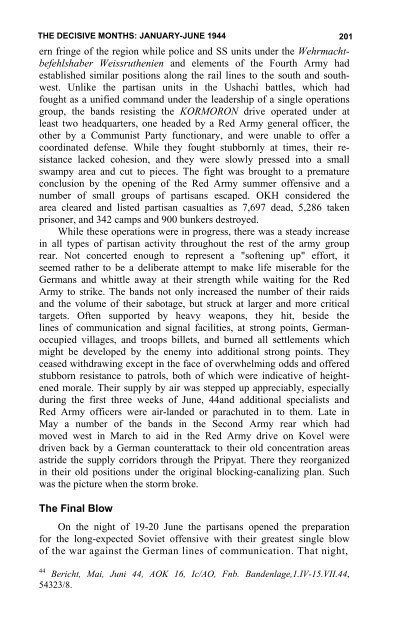the soviet partisan movement 1941-1944 by edgar m. howell
the soviet partisan movement 1941-1944 by edgar m. howell
the soviet partisan movement 1941-1944 by edgar m. howell
Create successful ePaper yourself
Turn your PDF publications into a flip-book with our unique Google optimized e-Paper software.
THE DECISIVE MONTHS: JANUARY-JUNE <strong>1944</strong> 201<br />
ern fringe of <strong>the</strong> region while police and SS units under <strong>the</strong> Wehrmachtbefehlshaber<br />
Weissru<strong>the</strong>nien and elements of <strong>the</strong> Fourth Army had<br />
established similar positions along <strong>the</strong> rail lines to <strong>the</strong> south and southwest.<br />
Unlike <strong>the</strong> <strong>partisan</strong> units in <strong>the</strong> Ushachi battles, which had<br />
fought as a unified command under <strong>the</strong> leadership of a single operations<br />
group, <strong>the</strong> bands resisting <strong>the</strong> KORMORON drive operated under at<br />
least two headquarters, one headed <strong>by</strong> a Red Army general officer, <strong>the</strong><br />
o<strong>the</strong>r <strong>by</strong> a Communist Party functionary, and were unable to offer a<br />
coordinated defense. While <strong>the</strong>y fought stubbornly at times, <strong>the</strong>ir resistance<br />
lacked cohesion, and <strong>the</strong>y were slowly pressed into a small<br />
swampy area and cut to pieces. The fight was brought to a premature<br />
conclusion <strong>by</strong> <strong>the</strong> opening of <strong>the</strong> Red Army summer offensive and a<br />
number of small groups of <strong>partisan</strong>s escaped. OKH considered <strong>the</strong><br />
area cleared and listed <strong>partisan</strong> casualties as 7,697 dead, 5,286 taken<br />
prisoner, and 342 camps and 900 bunkers destroyed.<br />
While <strong>the</strong>se operations were in progress, <strong>the</strong>re was a steady increase<br />
in all types of <strong>partisan</strong> activity throughout <strong>the</strong> rest of <strong>the</strong> army group<br />
rear. Not concerted enough to represent a "softening up" effort, it<br />
seemed ra<strong>the</strong>r to be a deliberate attempt to make life miserable for <strong>the</strong><br />
Germans and whittle away at <strong>the</strong>ir strength while waiting for <strong>the</strong> Red<br />
Army to strike. The bands not only increased <strong>the</strong> number of <strong>the</strong>ir raids<br />
and <strong>the</strong> volume of <strong>the</strong>ir sabotage, but struck at larger and more critical<br />
targets. Often supported <strong>by</strong> heavy weapons, <strong>the</strong>y hit, beside <strong>the</strong><br />
lines of communication and signal facilities, at strong points, Germanoccupied<br />
villages, and troops billets, and burned all settlements which<br />
might be developed <strong>by</strong> <strong>the</strong> enemy into additional strong points. They<br />
ceased withdrawing except in <strong>the</strong> face of overwhelming odds and offered<br />
stubborn resistance to patrols, both of which were indicative of heightened<br />
morale. Their supply <strong>by</strong> air was stepped up appreciably, especially<br />
during <strong>the</strong> first three weeks of June, 44and additional specialists and<br />
Red Army officers were air-landed or parachuted in to <strong>the</strong>m. Late in<br />
May a number of <strong>the</strong> bands in <strong>the</strong> Second Army rear which had<br />
moved west in March to aid in <strong>the</strong> Red Army drive on Kovel were<br />
driven back <strong>by</strong> a German counterattack to <strong>the</strong>ir old concentration areas<br />
astride <strong>the</strong> supply corridors through <strong>the</strong> Pripyat. There <strong>the</strong>y reorganized<br />
in <strong>the</strong>ir old positions under <strong>the</strong> original blocking-canalizing plan. Such<br />
was <strong>the</strong> picture when <strong>the</strong> storm broke.<br />
The Final Blow<br />
On <strong>the</strong> night of 19-20 June <strong>the</strong> <strong>partisan</strong>s opened <strong>the</strong> preparation<br />
for <strong>the</strong> long-expected Soviet offensive with <strong>the</strong>ir greatest single blow<br />
of <strong>the</strong> war against <strong>the</strong> German lines of communication. That night,<br />
44<br />
Bericht, Mai, Juni 44, AOK 16, Ic/AO, Fnb. Bandenlage,1.IV-15.VII.44,<br />
54323/8.
















